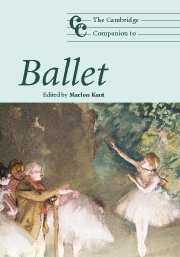Book contents
- Frontmatter
- Introduction
- Part I From the Renaissance to the baroque: royal power and worldly display
- Part II The eighteenth century: revolutions in technique and spirit
- Part III Romantic ballet: ballet is a woman
- Part IV The twentieth century: tradition becomes modern
- 17 The ballet avant-garde I: the Ballets Suédois and its modernist concept
- 18 The ballet avant-garde II: the ‘new’ Russian and Soviet dance in the twentieth century
- 19 George Balanchine
- 20 Balanchine and the deconstruction of classicism
- 21 The Nutcracker: a cultural icon
- 22 From Swan Lake to Red Girl's Regiment: ballet's sinicisation
- 23 Giselle in a Cuban accent
- 24 European ballet in the age of ideologies
- Notes
- Bibliography and further reading
- Index of persons
- Index of ballets
- Subject index
- The Cambridge Companion to Music
24 - European ballet in the age of ideologies
from Part IV - The twentieth century: tradition becomes modern
Published online by Cambridge University Press: 28 September 2011
- Frontmatter
- Introduction
- Part I From the Renaissance to the baroque: royal power and worldly display
- Part II The eighteenth century: revolutions in technique and spirit
- Part III Romantic ballet: ballet is a woman
- Part IV The twentieth century: tradition becomes modern
- 17 The ballet avant-garde I: the Ballets Suédois and its modernist concept
- 18 The ballet avant-garde II: the ‘new’ Russian and Soviet dance in the twentieth century
- 19 George Balanchine
- 20 Balanchine and the deconstruction of classicism
- 21 The Nutcracker: a cultural icon
- 22 From Swan Lake to Red Girl's Regiment: ballet's sinicisation
- 23 Giselle in a Cuban accent
- 24 European ballet in the age of ideologies
- Notes
- Bibliography and further reading
- Index of persons
- Index of ballets
- Subject index
- The Cambridge Companion to Music
Summary
Between 1789 and 1989 Europe and then the world chased the rapidly receding hope that human society could be remade. The struggle to renew the social order reached its zenith in the years before 1945 in modernism, socialism, Freudianism, expressionism, Bolshevism, Fascism, Nazism, the New Deal, the Mexican Revolution, Peronism and Gandhian nationalism. After 1945, the world froze into two blocks in which both the West and the East feared and suppressed experimentation, hunted and imprisoned radicals and stamped out the danger represented by the “youth movements”, the last and least powerful of the great attempts to transform human nature. The collapse of the Soviet Union and its satellite states ended the French revolutionary age and its attendant “isms”. Since 1991 Western capitalism has become the universal form of economic enterprise but with unexpected consequences. The two most populous states of the world, India and China, have turned out to be very good at capitalism and now threaten the economic futures of the United States and the European Union. Globalisation has also called forth the genie of resistance from the ancient Arab bottle – Wahabi Islam has emerged to reject every aspect of the great European experiment, especially the emancipation of women, in the name of an ancient theocratic puritanism.
- Type
- Chapter
- Information
- The Cambridge Companion to Ballet , pp. 272 - 290Publisher: Cambridge University PressPrint publication year: 2007
- 1
- Cited by

